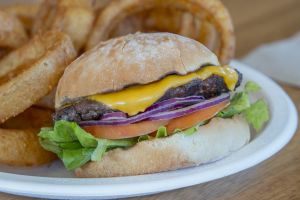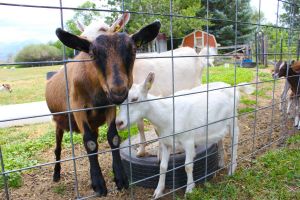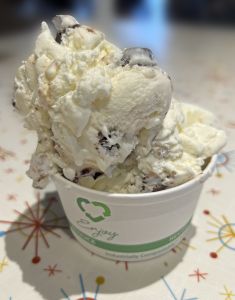Local Farms Feed Yellowstone
Exploring Local and Sustainable Dining in Yellowstone National Park
Sourcing food locally and sustainably is key to Yellowstone National Park Lodge’s dining facilities.
Yellowstone boasts many famous superlatives. It has the highest concentration and greatest diversity of wildlife — from grizzly bears to bison, trumpeter swans, and wolverines — in the Lower 48 states. It was the world’s first national park. It is home to more than 10,000 hydrothermal features, including more than half of the world’s geysers including the largest geyser in the world, Steamboat Geyser. It is the heart of one of the last intact temperate ecosystems in the world. And the park sits atop one of the world’s 20 supervolcanoes.
Here’s a less-known superlative: The growing season in the communities surrounding Yellowstone National Park is among the shortest in the United States. Farmers around Yellowstone have, on average, a 91-day growing season. Even Alaska’s growing season is longer — about 105 days — and growers in that state enjoy about 2 months of 24-hour sunlight.
Still, Yellowstone National Park Lodge’s dining rooms, cafes, grills, and cafeterias can offer park visitors menus that feature about 60% locally sourced food. “We’re proud of this, and it is absolutely something that we need to do,” says Lu Harlow, who has been the Director of Food and Beverage in the park for 30 years. “It is an expectation — both from visitors and also from us internally that we, in the world’s first national park, are making decisions that are good for the environment.”
Director of Environmental Programs for Yellowstone National Park Lodges, Dylan Hoffman, says sourcing so much locally isn’t easy. Still, the company is committed to it and something that guests increasingly care about. “We see more and more diners asking questions about where their food is from,” he says. “We’re proud to tell them that their burger is from Mulvey Gulch Ranch in Boulder, Mont. (about 160 miles north of Yellowstone).” About bison Harlow says, “anytime you see bison on any menu — from bison short ribs or bison tartare in the Obsidian Dining Room at Old Faithful Snow Lodge to a bison bratwurst at the Mammoth Terrace Grill — it is sustainable. We are sourcing it locally.”

Wylie’s Burger from Wylie’s Canteen at Lake Lodge
Harlow, who grew up on a small farm in New Hampshire herself, remembers the very first rancher who reached out to the park about buying his beef around 2000 or 2001. “It was tricky because he wanted us to buy the whole animal and we were never set up for butchery,” she says. “But we did it because we thought it was important.” Thanks to her farming background, Harlow says her goal is always to support small family farms and ranchers.
As the years went on, “we slowly expanded, biting off small chunks when we could,” Harlow says. And then, when negotiating its contract with the National Park Service in 2013, Yellowstone National Park Lodges included a promise that it would work towards sourcing 70% of its food sustainably. “Sustainable” was defined as food that is either third-party verified organic and/or from within a 500-mile radius of the park.
Pointing out that a 500-mile radius allows for companies like Dannon (yogurt) to be considered “local” to Yellowstone, Harlow says she “really tries to look at everything and make sure that it is truly sustainable. You have to be careful with greenwashing. We want what we’re doing to be impactful, not just something that sounds good when we talk about it.”
Meet some of the local farmers and ranchers who feed visitors to Yellowstone
Amaltheia Organic Cheese

Goats at Almatheia Farm
Any time you see goat cheese on a menu at a Yellowstone National Park Lodge’s restaurant, it’s likely from Amaltheia Organic Dairy, whose name comes from Greek mythology. (“Amaltheia” was the name of the goat that nursed Zeus, who grew up to become king of the gods; Zeus honored her by putting her image in the sky — the constellation Capricorn.) “We love using and supporting Amaltheia,” says Harlow. “I’ve heard from (founder) Sue Brown that our support has helped the family keep the dairy and build its business.” The Charcuterie & Fromage appetizer on the lunch and dinner menus at Lake Yellowstone Hotel Dining Room includes Amaltheia organic goat cheese.
Mel and Sue Brown founded their dairy in Belgrade, Mont., 90 miles from both the park’s West Yellowstone and Gardiner entrances, in 2000. Milking 90 goats, the couple initially sold their milk to a distributor making gourmet cheese for California customers. In 2002, they decided to create their own cheese facility.
Today, the second generation of Browns, siblings Sarah and Nate, are also involved. Sarah is head cheese maker and Nate started a pig and vegetable operation on the farm. Amaltheia composts goat manure and uses it to help grow vegetables; its pigs are fed whey from the cheese production.
Big Dipper Ice Cream

Big Dipper Moose Tracks Ice Cream
Founded in Missoula, Mont., in 1995, Big Dipper handcrafted ice cream has been included on Food and Wine magazine’s “Best Ice Cream in Every State” list. It is “on every one of our dining room menus and ice cream shops at Canyon Village, Old Faithful Inn, & Old Faithful Lodge,” Harlow says. In 2024, Yellowstone National Park Lodges expects to scoop out more than 21,500 gallons of Big Dipper ice cream. Huckleberry (a tart-sweet berry that grows in the cool mountains of the northwestern United States) is the most popular flavor, followed by salted caramel. “I think people like huckleberry because it is a novelty,” Harlow says. “It’s not a flavor you can find everywhere.” Big Dipper’s flagship shop, in Missoula, MT (a classic drive-in), is about 265 miles northwest of Yellowstone’s Gardiner entrance.
Yellowstone Soup Co.
The family-owned and -operated Yellowstone Soup Co. was founded 20 years ago in New England, and in 2020 opened a manufacturing facility in Big Timber, Mont., about 90 miles northeast of Yellowstone’s Gardiner entrance. “You can find soups and chilis from Yellowstone Soup Co. everywhere in the park,” Harlow says. Popular soups include the company’s Montana Bison Chili and Golden Curry Lentil Quinoa Soup, both of which source ingredients from Montana, Idaho, South Dakota, and North Dakota.
Written by: Dina Mishev
Dina Mishev is the editor-in-chief of Jackson Hole magazine.
For A World of Unforgettable Experiences® available from Xanterra Travel Collection® and our sister companies, visit xanterra.com.
Want to experience Yellowstone in-depth? See what makes Yellowstone National Park a great place to work for a season or longer!